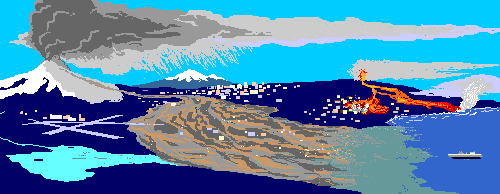| Gas | Lahars | Landslides | Lava Flows | Pyroclastic Flows | Tephra |

|
|
|
|
Volcano Hazards: | Types
and Effects
| Location | | Gas | Lahars | Landslides | Lava Flows | Pyroclastic Flows | Tephra | |
|
Examples of a few volcano hazards near erupting volcanoes:
lahars, lava flows, pyroclastic flows, tephra, volcanic gases  Illustration by B. Myers
|
|
Volcanoes generate a wide range of activity that can affect the surrounding land, river valleys, and communities in different ways. Depending on the type, size, and duration of the eruptive activity, hazardous areas might exist only within a few kilometers of a volcano or extend to areas more than a hundred of kilometers from an active vent. We can identify areas most likely to be affected in the future by volcano hazards--lahars, lava flows, landslides, pyroclastic flows, tephra, and volcanic gases--through a detailed study of a volcano's natural history. By knowing the distance that previous types of activity spread from a volcano and the present landscape, and learning from the effects of historical eruptions, we can identify hazardous zones around a volcano. |
|
In order to determine the general location of volcano hazard areas on Earth, we first need to know where the world's most active volcanoes are concentrated. Active volcanoes are not randomly distributed over the Earth's surface. Instead, they tend to be located in linear volcanic mountain chains thousands of kilometers long on the edges of continents, in the middle of oceans, or as island chains. The locations of these volcanic chains are closely related to the way in which Earth's crust is divided into more than a dozen enormous sections or "plates" and how the plates move relative to one another according to the theory of plate tectonics. |
|
|
|
According to the theory of plate tectonics, these rigid plates, whose average thickness is about 80 km, move in slow motion on top of the Earth's hot, pliable interior. Most of Earth's active volcanoes are located along the boundaries of these massive plates where they spread apart or collide. But some of the world's most active volcanoes, like Kilauea Volcano on the Island of Hawai`i, are found in the middle of these massive plates above hot spots in the Earth's interior. |
|
an illustrated booklet about plate tectonics available online from the U.S. Geological Survey. |
|
Volcanoes and Plate Boundaries
|
|
More than 50 volcanoes have erupted one or more times times in the past few hundred years in Alaska, Hawai`i, Washington, Oregon, and California. As part of our legislated responsibility to issue warnings of hazardous volcanic activity in the United States, we have identified volcano-hazard zones around many active and potentially active volcanoes. Our volcano-hazard assessments are based on the assumption that the same general areas around a volcano are likely to be affected by future volcanic activity of the same type and at about the same average frequency as in the past. Through detailed geologic mapping of the type and size of past eruptions, we estimate the areas most likely to be affected by similar events in the future. |
|
Long Valley Caldera, California
Hawai`i
|
|
| Home |
U.S. volcano activity | World volcano activity |
Photo glossary |
Highlights |
| Search this site |
Site index |
Volcano observatories |
Educator's page |